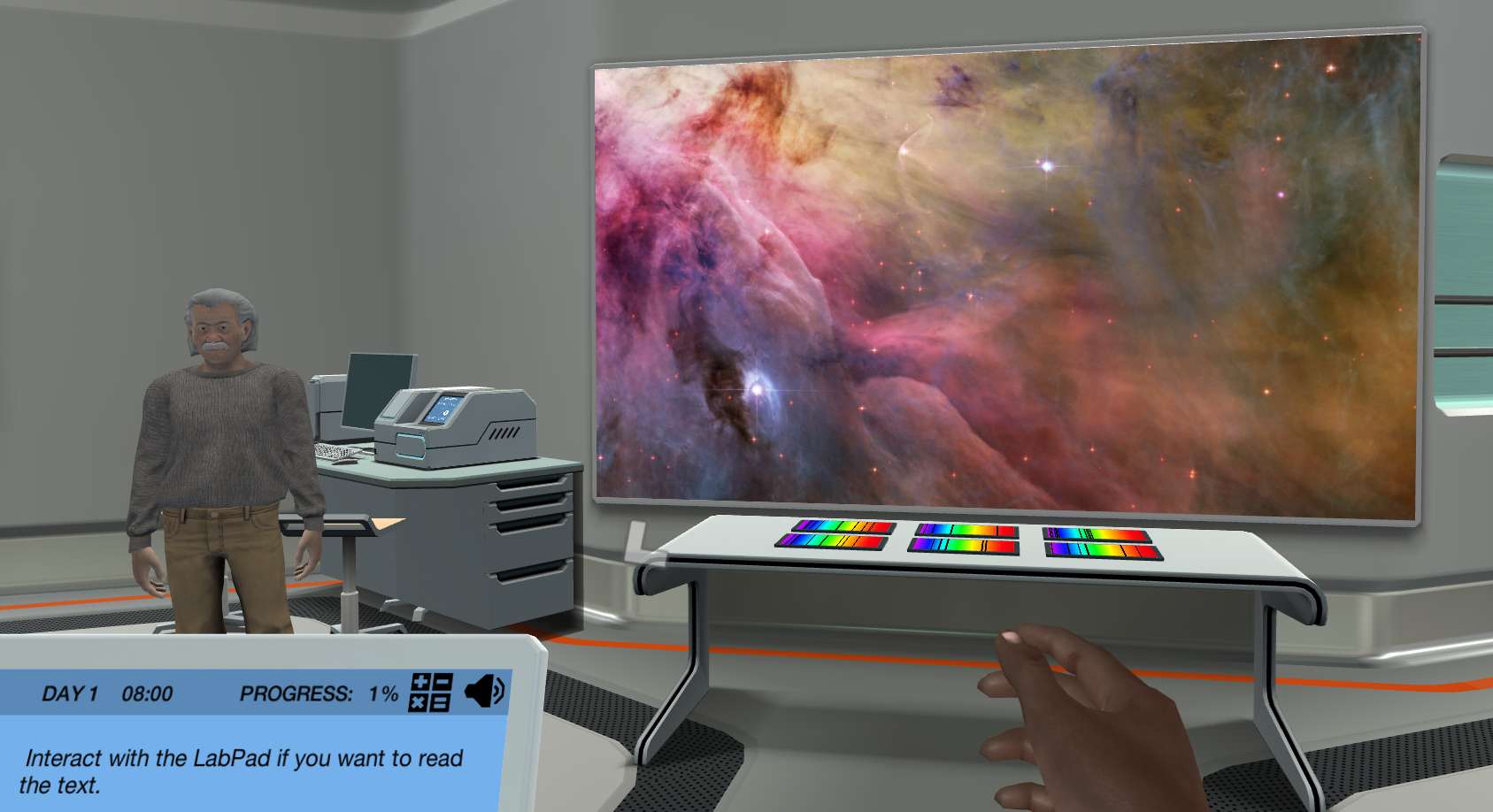Heading 1
Heading 2
Heading 3
Heading 4
Heading 5
Heading 6
Lorem ipsum dolor sit amet, consectetur adipiscing elit, sed do eiusmod tempor incididunt ut labore et dolore magna aliqua. Ut enim ad minim veniam, quis nostrud exercitation ullamco laboris nisi ut aliquip ex ea commodo consequat. Duis aute irure dolor in reprehenderit in voluptate velit esse cillum dolore eu fugiat nulla pariatur.
Block quote
Ordered list
- Item 1
- Item 2
- Item 3
Unordered list
- Item A
- Item B
- Item C
Bold text
Emphasis
Superscript
Subscript
About This Simulation
Explore the atomic model, absorption and emission spectra, and how they reveal information about stars in galaxies far far away.
Learning Objectives
- Describe the historical evolution of atomic models
- Describe how the atomic emission spectra are produced using Bohr's model
- List the four quantum numbers
- Use atomic spectra to identify the composition of a gas
About This Simulation
Lab Techniques
Related Standards
- HS-PS1-1
- AP Chemistry 1.5 Atomic Structure and Electron Configuration
- 2.1 The nuclear atom
- 2.2 Electron configuration
Learn More About This Simulation
This is the principles (high school) version of the simulation. For a more advanced version please see “Atomic Structure: Assess the possibility of life on other planets”. Did you know that there are approximately 7 billion billion billion (that is, 7 octillion!) atoms in a grown human body? That number is higher than the estimated number of stars in the observable universe! In this simulation, you will investigate the atomic models and discover what unique properties they possess that allow us to study the universe.
Explore the history of the atom
To understand our surroundings, we must first understand its smallest building block, the atom. Embark on a journey that stretches from ancient Greece until today and learn how our understanding of the modern atomic model came to be.
Investigate Bohr and quantum 3D models
Explore the Bohr and Quantum atomic models on the holographic table to learn about their similarities and differences. You will learn why the bizarre nature of electrons led scientists to come up with the concept of the four atomic quantum numbers, as well as what these four numbers represent. With the help of illustrative 3D models and interactive explanations, you will understand how electron transitions between energy levels explain the emission and absorption spectra of a gas.
Use your knowledge to help an astrophysicist
Use your newly acquired knowledge of atomic energy levels to help Dr. Nova with real spectrographic techniques to determine the composition of distant stars, matching their spectra to that of different elements.
Will you be able to determine the atomic composition of a star?
For Science Programs Providing a Learning Advantage
Boost STEM Pass Rates
Boost Learning with Fun
75% of students show high engagement and improved grades with Labster
Discover Simulations That Match Your Syllabus
Easily bolster your learning objectives with relevant, interactive content
Place Students in the Shoes of Real Scientists
Practice a lab procedure or visualize theory through narrative-driven scenarios


FAQs
Find answers to frequently asked questions.
Heading 1
Heading 2
Heading 3
Heading 4
Heading 5
Heading 6
Lorem ipsum dolor sit amet, consectetur adipiscing elit, sed do eiusmod tempor incididunt ut labore et dolore magna aliqua. Ut enim ad minim veniam, quis nostrud exercitation ullamco laboris nisi ut aliquip ex ea commodo consequat. Duis aute irure dolor in reprehenderit in voluptate velit esse cillum dolore eu fugiat nulla pariatur.
Block quote
Ordered list
- Item 1
- Item 2
- Item 3
Unordered list
- Item A
- Item B
- Item C
Bold text
Emphasis
Superscript
Subscript
A Labster virtual lab is an interactive, multimedia assignment that students access right from their computers. Many Labster virtual labs prepare students for success in college by introducing foundational knowledge using multimedia visualizations that make it easier to understand complex concepts. Other Labster virtual labs prepare learners for careers in STEM labs by giving them realistic practice on lab techniques and procedures.
Labster’s virtual lab simulations are created by scientists and designed to maximize engagement and interactivity. Unlike watching a video or reading a textbook, Labster virtual labs are interactive. To make progress, students must think critically and solve a real-world problem. We believe that learning by doing makes STEM stick.
Yes, Labster is compatible with all major LMS (Learning Management Systems) including Blackboard, Canvas, D2L, Moodle, and many others. Students can access Labster like any other assignment. If your institution does not choose an LMS integration, students will log into Labster’s Course Manager once they have an account created. Your institution will decide which is the best access method.
Labster is available for purchase by instructors, faculty, and administrators at education institutions. Purchasing our starter package, Labster Explorer, can be done using a credit card if you are located in the USA, Canada, or Mexico. If you are outside of North America or are choosing a higher plan, please speak with a Labster sales representative. Compare plans.
Labster supports a wide range of STEM courses at the high school, college, and university level across fields in biology, chemistry, physics, and health sciences. You can identify topics for your courses by searching our Content Catalog.















